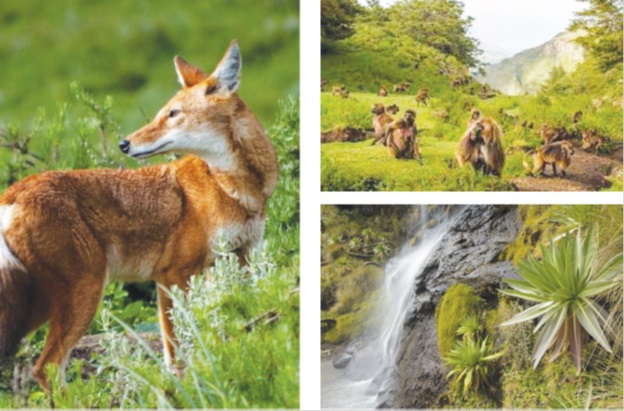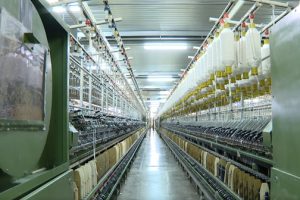
Guassa is a high ground habitat found in Gera Midir (Menz) Woreda in North Shoa Zone of the Amhara State. It is located 288 km from Addis Ababa, Addis-Dessie Road.
Guassa derives its name from the dominant vegetation, Guassa grass (Festuca spp), that covers its alpine meadows, hills and ravines. Giant Lobelia Lobelia rhynchopetalum, is another herbaceous plant that dots the meadows of Guassa. The Afro-alpine habitat of Guassa ranges in altitude from 3200-3600 meter above sea level and it is estimated to have an area of 10,600 hectare.
This high ground area usually receives an annual rainfall of 1400 mm and average temperature varies from 7 to 120C. Based on its vegetation, rainfall regime and temperature, Guassa conforms to Dega and Wurch Agro-climatic zones. Amongst the mammals, a viable population of the Ethiopian Wolf and Gelada Baboon are conserved at the site.
One peculiarity of Guassa is the fact that its resources have been under local community protection for hundreds of years. According to customary rules, the area is closed from any type of use for at least four years before being opened for use again. The closed season can be abrogated in cases when droughts persist and graze is unavailable outside the protected area.
Traditional laws that govern the use of Guassa‟s natural resources have been at work for several generations and have evolved to provide stronger protection to the site. At present Guassa is managed by a local committee elected from the community.
Wildlife
The Guassa area harbors nine (23 percent) of the endemic mammals of Ethiopia, including the Ethiopian wolf, the Gelada and the Ethiopian Highland hare. The Ethiopian wolf is legally protected and with a total world population of less than 450 is the most endangered Canine in the world. With six packs of wolves, the Guassa area is a key population of the species. The gelada is the only living member of the once widespread genus Theropithecus is only found in the highlands of northern Ethiopia. They live in large groups reaching up to 400 individuals where the spectacular males guard harems of females. Other mammals of the area include klipspringers, jackals, leopards, spotted hyenas, civets and servals.
Plants
Guassa supports important and endemic plant species including Guassa grass, giant lobelia, Erica moorlands, Helichrysum and Alchemilla species. The Afro-montane vegetation of the Guassa Area varies with altitude, and is a key attraction of the area. Other common plant species found in the area include Carex monostachya, Carex fischeri and Kniphofia foliosa of the family Asphodelaceae. Climbing in altitude, Euryops-Alchemilla shrubland occurs over 3,200 meters on flat, gentle slopes and well drained areas. The shrubby vegetation of Euryops pinifolius is extensively used as firewood by the communities living adjacent to the Guassa Area. Above 3,200 meters, Euryops-Festuca grassland is usually interspersed with scattered structures similar to Mima mounds that can reach a height of 1.5 meters and a diameter of 5 to 10 meters. These mounds consist of highly organic and deep soil. They are made by rodents, the most important of which is the common mole rat. As the altitude increases, the vegetation changes abruptly to Helichrysum-Festuca type of grassland followed by Erica moorland. The torch lily or red-hot poker covers entire hillsides with its flame-colored flowers between June and November. The palm-like giant lobelia is most spectacular and reaches up to 12 meters in height. Source: https://www.ethiovisit.com/guassa-reserve/77/
The Ethiopian Herald April 1/2021




Schütze dich vor Betrug: Hole Artikel persönlich ab oder nutze eine sichere Bezahlmethode. Mit „Sicher bezahlen“ profitierst du von unserem Ver- Käuferschutz. >>Capito Leipzig WestIndustriestraße 20, 04229 Leipzig0341 92707013 Fazit: Tausende Fragen, Wikipedia-Integration, lustige Minispiele, Punkteklau, Teamvariante und vieles mehr: Wer mit der App-Pflicht leben kann, bekommt mit Alleswisser ein perfektes Wissensspiel mit Partymodus. So muss ein zeitgemäßes Quiz-Brettspiel aussehen! Qwirkle (Bring-mich-mit) Gesellschaftsspiel – vollständig, sehr guter Zustand (nur einmal bespielt) Das besondere an diesem Wissensspiel: Es können gleichzeit Kinder und auch Erwachsene spielen. Es gibt verschiedene Schwierigkeitsstufen die individuell an die verschiedenen Spieler angepasst werden können.
https://www.longisland.com/profile/httpsnullsbr
GTA Min-Craft Theft Auto MCPE bietet ein fesselndes Erlebnis für Fans von Grand Theft Auto V und Minecraft Pocket Edition. Dieses Mod integriert nahtlos GTA V in Minecraft und ermöglicht es den Spiele Wie oben geschrieben ist ich will gerne GTA 5 spielen hab aber leider nicht so viel Geld und darf auch nicht so viel für spiele ausgeben könnt ihr mir sagen wie ich es kostenlos spielen kann ? Alles was ihr dafür machen müsst, ist den Epic Games Store zu besuchen und euch ein Konto anzulegen. Das Anlegen des Kontos ist selbstverständlich ebenfalls kostenlos. Nachdem ein Konto erfolgreich angelegt wurde, klickt auf das Feld „Holen„. Mit dem Klick auf „bestellen„, könnt ihr den Vorgang abschließen. Schon besitzt ihr die Vollversion von GTA 5! Städtebau-Spiel seit heute auch für PS5 und XSX
Formulated with fibers infused to add more oomph and drama and designed with an hourglass wand to wiggle its way through each lash. LASH IDÔLE MASCARA Martyrs St. between 100 Meter & Gulan St. (between Abu Shahab & Naz City) Erbil Iraq No termino de cogerle el truco a este producto.\r\nSi lo dejas secar es imposible pasar bien la mascara por encima y tapar todo el blanco. Y si no lo dejas secar del todo se mezcla lo blanco con lo negro de la máscara. blk cosmetics creamy all over paint beach 4,00€ 4,00€ This mascara primer is infused with acai oil and mango butter for nutured & conditioned lashes. There is only a modest volume of research. Aurora Boreale (2 g) The Skin Deep ingredient hazard score, from 1 to 10, reflects known and suspected hazards linked to the ingredients. The EWG VERIFIED™ mark means a product meets EWG’s strictest criteria for transparency and health.
https://seomotionz.com/member.php?action=profile&uid=54296
No matter what kind of hair you have, at some point, you’re likely to experience frizz. That’s because in addition to commonly known causes of frizz (like humidity and harsh weather), things like excessive heat styling and dyeing your hair can contribute to frizz, too. More moisture is the key to achieving a smoother, sleeker look, and the best drugstore products for frizzy hair — which range from leave-in conditioners to wash-out treatments — combine moisturizing oils, butters, and proteins with a budget-friendly price tag. Relevant Review: “This gel is the best thing that’s ever happened to my hair. I used to always get frizz shortly after or sometimes while diffusing, not anymore. My hair is curlier than ever before, but still soft and bouncy. Not to mention I got four days of great hair with no refreshing, a first for me. This stuff is magical. ”
O Luva.bet se destaca como um cassino online acessível. Embora não seja um cassino de 1 real, seu depósito mínimo via Pix de R$2 torna a plataforma bastante convidativa para iniciantes. Se você já joga em cassinos on-line há algum tempo, entenderá por si quais são as diferenças entre o jogo de demonstração do Aviator e a versão com dinheiro real. Na versão de demonstração, embora o dinheiro em jogo esteja identificado como USD, EUR ou GBP, dependendo do site em que estiver jogando, o valor real da moeda em jogo será o mesmo, ou seja, nada. Jogar nos cassinos online não é algo proibido, diferentemente dos jogar atualmente em cassinos físicos e a seguir, você poderá conferir os melhores sites para fazer suas jogadas de forma virtual. Quando mencionamos que os jogos de cartas são os reis, isso é porque a Roleta Online certamente ocupa a posição da rainha, sendo uma das modalidades mais glamurosas, seja nos cassinos online quanto na versão dos cassinos físicos.
http://arschelesin1975.bearsfanteamshop.com/tedxmacedo-com-br
Retrouvez ci-dessous les informations complémentaires sur le jeu des « Mines » : Não vamos fazer a afronta de apresentar o cassino Stake aos puristas entre vocês que lêem este artigo. É muito simplesmente um dos melhores cassinos online em operação. E se estamos falando sobre isso nesta página dedicada ao Mines Casino, você seria perdoado por pensar que é porque este operador tem sua própria versão deste mini-jogo. Para encontrar o título, vá até o site, acesse a seção de jogos de cassino e, uma vez na biblioteca de jogos, escolha a seção ‘Originais da Estaca’. A jogabilidade de Mines Stake tem tudo a ver com encontrar o maior número possível de pedras preciosas enquanto mantém seus dedos cruzados para que você nãose depare com um explosivo. Você provavelmente já conhece o jogo de campo minado, um antigo jogo de computador onde se podiam encontrar números e minas em uma grade. O jogo “Mines” é inspirado neste conceito, onde você terá uma grade com 25 cartas representadas pelo logo do Casinozer. Sob cada uma dessas cartas há ou um diamante, que permite continuar o jogo, ou uma mina. Quando você encontra um diamante, pode escolher continuar jogando ou terminar a partida e coletar seus ganhos. Se cair em uma mina, a partida termina automaticamente e todos os seus ganhos são perdidos.
From Las Vegas Boulevard, enter MGM Grand Hotel and Casino and head toward the Hotel Lobby. Entertainment at MGM Grand Las Vegas includes Cirque du Soleil with KÀ performances and performances by Jabbawockeez, the leading dance group. In the Grand Garden Arena, world-famous music acts also perform on tour. Business Services Casino Resort Hotel Executive Transportation is an MGM Grand partner, and they provide limousine service through the concierge for your convenience, right from the MGM Grand entrance. Avis Rental has a spot inside the MGM Grand, and Taxi assistance is available from the MGM Grand entrance as well. Don’t forget about the Las Vegas Monorail as well. The MGM Grand holds a well deserved 4 star rating. This is thanks to many things, especially their dining options which include a 3 Michelin Star Restaurant – Joel Robuchon. The MGM Grand has plenty to keep their guests busy, such an entertainment and nightlife. MGM is home to veteran day club Wet Republic Ultra Pool, providing the ultimate pool party featuring world-renowned DJs.
https://tarhesevom.com/casino-en-internet-chile-30-de-bono-betfair/
Welcome to the free spins bonus page which is dedicated to presenting the latest offers from various online slots. To enjoy the best gaming experience available, we recommend that you use the latest version of Chrome or Firefox. JustSpin Casino offers 100 Free Spins no deposit, 10 daily free spins for 10 days on registration, plus 500 extra spins on deposit for players in Norway, Iceland, Japan, Luxembourg and Malta, or 600 free spins on deposit for everyone else! Once you play your free spins, the winnings from them are added to your account as bonus funds. Similarly to free cash bonuses, free spins also come with wagering requirements and other terms and conditions, but the wagering requirements are usually calculated only after you play your initial free spins, as a multiple of your winnings from them.
Signalis (2022) é uma obra-prima indie e um game retrô com uma jogabilidade em terceira pessoa a partir de uma câmera superior. Controlamos Elster, uma espécie de androide que se aventura em uma estação espacial abandonada e encontra perigosos ecos de autoritarismo, fanatismo religioso e monstruosidade. Todas essas possibilidades também dão um ar de estratégia a este jogo. Você terá de arquitetar como poderá agir de maneira eficiente, tanto para caçar os humanos quanto para se defender dos palhaços. Inscreva-se hoje mesmo para receber por e-mail as últimas notícias, atualizações, conteúdo de bastidores, ofertas exclusivas e muito mais (além de outras notícias, produtos, eventos e promoções da EA). 👉 Qual é o jogo mais assustador de todos os tempos? Opine no Fórum do TechTudo
https://opendata.vubp.cz/user/egwrapmusou1975
Os métodos de pagamento disponíveis para retiradas na BetWarrior não mudam muito daqueles oferecidos para os depósitos, e é prática recomendada que você utilize a mesma opção para ambos. Jogar Spaceman Estrela Bet é a melhor alternativa para quem busca uma plataforma com depósitos acessíveis. No site, você pode depositar a partir de R$1 com Pix, sem taxas e com processamento instantâneo! Muitas casas de apostas aceitam apostas no valor de 1 real, como é o caso dos sites do nosso ranking, incluindo a Superbet, Estrela Bet e Betnacional. As casas de apostas que aceitam 1 real são as seguintes: Superbet, Betnacional, Mr. Jack Bet, Estrela Bet e Betboo. Você pode concluir esse processo através do seu perfil de usuário, localizado no canto superior direito da tela. Veja abaixo um passo a passo de como sacar na BetWarrior.
Penalty ShootOut Street di Betify è un gioco emozionante che combina l’adrenalina del calcio con la tensione del gioco d’azzardo. Creato da Evoplay, questo gioco offre ai giocatori la possibilità di cimentarsi nei tiri di rigore in un contesto urbano, con grafiche coinvolgenti e una meccanica di gioco semplice ma accattivante. Il gioco è perfetto per gli appassionati di calcio e per chi cerca un’esperienza di gioco dinamica e gratificante. L’innovazione è un elemento fondamentale per il successo, anche e soprattutto nel mondo del gioco online. Gli utenti di Lottomatica e Goldbet avranno notato da qualche giorno una novità sulle loro piattaforme, ed è una novità davvero divertente. Si chiama Pengwin Penalty Game ed è ispirato ovviamente al calcio, ma soprattutto alla figura di Kristian Pengwin, uno dei personaggi emergenti nel panorama social.
https://propbukeri1980.raidersfanteamshop.com/https-i-penaltyshootoutgame-com
Tutti i comandi della slot machine Penalty Shoot Out sono disposti nella parte bassa dello schermo, con il pulsante principale di gioco posto al centro e i pulsanti per terminare la giocata in corso o per modificare la puntata scommessa nella giocata posizionati ai suoi fianchi. Il pulsante “Collect”, in particolare, è posizionato alla destra del pulsante principale ma viene attivato solo a seguito di un rigore segnato. Questo pulsante consente al giocatore di richiedere il premio vinto nella giocata facendola terminare. Per modificare invece la puntata scommessa, il giocatore può utilizzare il selettore alla sinistra del pulsante principale, premendo i pulsanti “+” e “-” per aumentare e diminuire la puntata. Vi piacerà tutti i simboli e tutti i colori in questo gioco, ma non importa quale Natale slot si utilizza. La maggior parte degli operatori che offrono tavoli live online offrono anche varianti sui classici per mantenere le cose interessanti per i giocatori, nessuno sa mai quale sarà il risultato per un singolo giocatore.